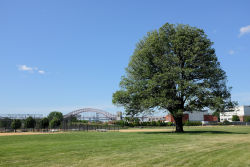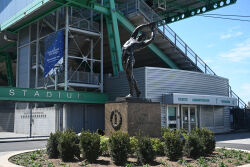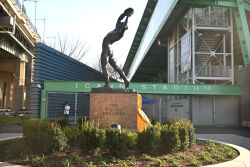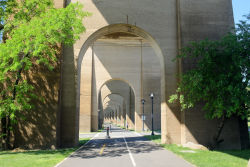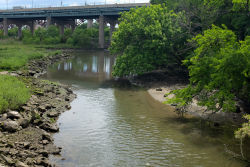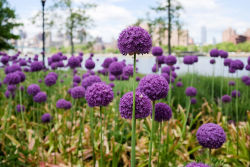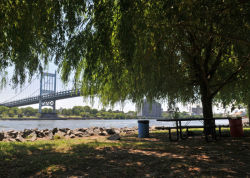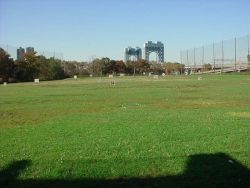Randall's Island Park
The Hell Gate Pathway
The Hell Gate Bridge and Railroad Viaduct span Randall’s Island Park approximately 100 feet above ground, with heavy piers of stone planted firmly in Astoria to the east and Randall’s Island to the west, and a viaduct stretching north into the Bronx. Its bowstring truss steel arch (1,017 feet long) crosses over the notorious ‘Hellegat’, a channel so named by Dutch sailors for the treacherous currents at this turn in the East River. Built initially for freight traffic, the bridge connects to the Bronx and Queens, with Randall’s Island as the keystone, providing a critical rail link for both passenger and freight along the 457-mile northeast corridor between Boston and Washington D.C. that continues to this day.
Designed by the architect Henry Hornbostel (1867-1961) and engineer Gustav Lindenthal (1850-1935) soon after they had completed the Queensboro Bridge (opened 1908), the Hell Gate Bridge opened in 1917. Its weighty proportions – the masonry pylons, the steel bowstring trusses resembling a triumphal arch, no less than four lanes of railway ties – were considered almost excessive for the time. The bridge and viaduct construction was a massive undertaking, involving an engineering team numbering more than 70 men, and countless laborers. The railway industry was at its peak – hence, the elegant detail of the piers (designed by Hornbostel) and the grand scale of the whole. Lindenthal, a self-taught engineer, configured the stately archway, which now stands in bold contrast to its younger sibling to the west, commonly known as the Triborough Bridge (built in 1936). Three days after the Hell Gate Bridge opened, the country entered World War I, and the four track bridge was immediately employed to convey troops to the port cities. The bridge came quickly into its own. From the bridge proper stems the viaduct – a long arcade of 100 foot high Romanesque arches made of sandy-colored concrete, recalling the form and grand march of a Roman aqueduct. The route beneath the arcade has been converted to the new Hell Gate Pathway, a dedicated pedestrian and bike path that runs through the monumental arcade, connecting to the larger waterfront pathway system that circles the Island. Slated for completion in 2013, the northern end of the Pathway will lead across the Bronx Kill via an at-grade crossing to the South Bronx Greenway --- and onward to the larger Bronx Borough Greenway. This industrial corridor of steel trusses and concrete arches is now fashioned for shared use – above by freight and passenger rail traffic, and below by park pilgrims on foot and bicycle.
The Pathway was developed by the Randall’s Island Sports Foundation (RISF) in public/private partnership with the New York City Department of Parks & Recreation (DPR), and working closely with the New York City Economic Development Corporation. Design was funded through a federal DOT Transportation Enhancements Program (TEP) grant with a local match from the Manhattan Borough President, and construction was made possible by Environmental Protection Fund grants from the New York State Department of State and the New York State Office of Parks, Recreation and Historic Preservation alongside funding from the Office of the Mayor of the City of New York. Special thanks go to Amtrak, which today still runs its Northeast Corridor service along the Hell Gate Bridge, and which partnered with RISF and DPR by performing a $15 million project to prevent falling debris, assuring safe passage over the pathway below.
The Hell Gate Pathway bears witness to the adaptive uses of the railway and its partnership with greening movement.
Check out your park's Vital Signs
Clean & Safe
Green & Resilient
Empowered & Engaged Users
Share your feedback or learn more about how this park is part of a
Vital Park System

